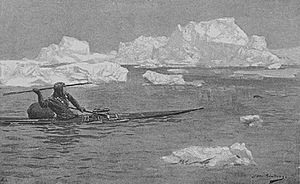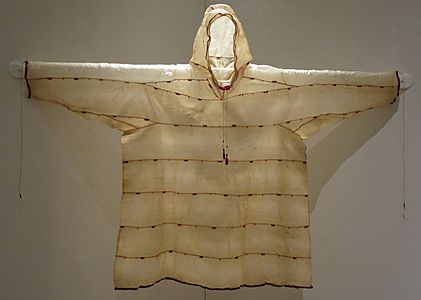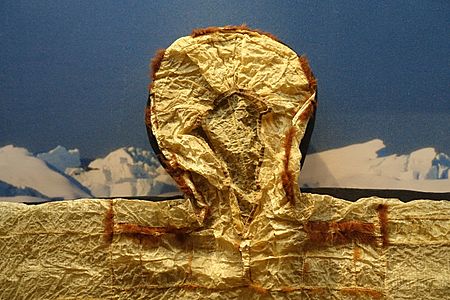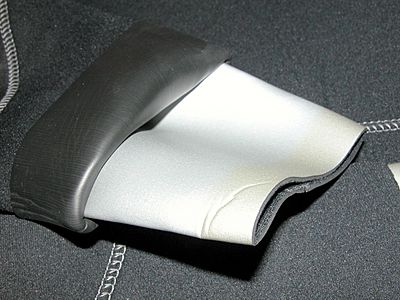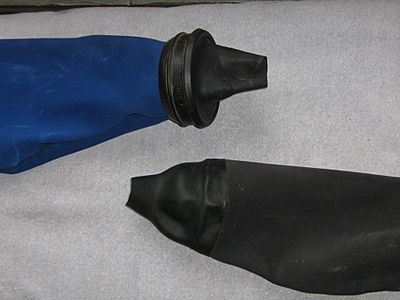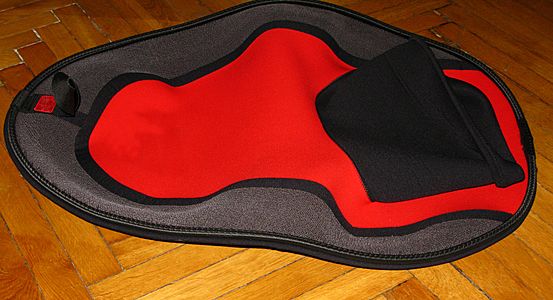Tuilik facts for kids
A tuilik is a special waterproof jacket used by Inuit people when they paddle a kayak. It's designed to keep the paddler completely dry. This jacket seals tightly around the face, wrists, and the edge of the kayak's opening (called the coaming). This way, if the kayak flips over, the paddler can turn it back upright using a kayak roll without getting wet or letting water into the boat.
The air trapped inside a tuilik also helps make rolling easier. If a paddler accidentally falls out of their kayak, the tuilik provides some floatation. They can even pull their legs up into the air pocket for more buoyancy. People can wear life vests over or under a tuilik.
Sometimes, especially in summer, kayakers might use an akuilisaq instead. This is a spray skirt that covers the kayak's opening but isn't connected to a jacket. Many modern kayakers use a separate spray skirt and a special kayaking top. This top usually seals around the waist, arms, and neck. A tuilik, however, combines the skirt and top into one piece. It has a hood that seals around the face instead of a neck seal. Tuiliks often allow more freedom of movement, but they need to fit just right.
How a Tuilik Fits and Works
A tuilik's hood needs to fit snugly around your face. However, the arms and body should be loose enough for you to move freely and wear clothes underneath. When doing a kayak roll, you need extra length in the body part of the tuilik. Traditionally, people used quick-release suspenders to lift the front. This stopped water from collecting in the extra fabric. The tuilik must seal tightly at your face and around the kayak's cockpit. It usually seals at the wrists too, unless it has built-in mittens.
Traditional tuiliks were made to fit narrow, custom-built kayak cockpits. Today, many kayaks are mass-produced with larger openings. This means modern tuiliks need to be wider at the bottom. Some tuiliks even have a double "deck" part. This helps them fit different sizes of kayak cockpits.
You can buy tuiliks that are custom-made to your size. Or, you can find them in many different ready-made sizes. Some people even make their own tuiliks. They sew or glue a commercial dry top (a waterproof jacket) and a spray skirt together. This creates one waterproof piece of clothing.
What Tuiliks Are Made From
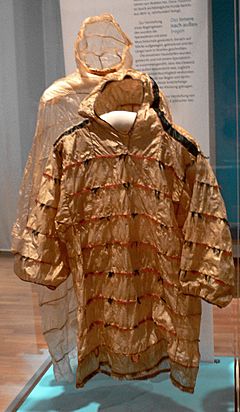
In the past, tuiliks were often made from specially prepared seal-skin. They were sewn together using sinew (strong fibers from animals). These sealskin tuiliks were soaked, stretched, rubbed, and greased. This kept them soft and waterproof.
Another traditional material for tuiliks was animal gut. This came from the intestines of sea mammals or bears. The gut was cleaned, then inflated to dry quickly. Gut dried in cold, dark, windy weather became white and opaque, called "winter gut." "Summer gut" was yellowish and more see-through. The dried gut was then cut into strips and sewn into a garment. The smooth inside of the gut became the outside of the tuilik.
Modern tuiliks are often made from neoprene. These are called tuiliusaq, meaning "tuilik-like." Neoprene tuiliusaqs offer good floatation and keep you warm in cold water. This makes them feel quite different from traditional sealskin tuiliks.
Thinner materials can feel more like the traditional sealskin. Some tuiliks have been made from cotton canvas. Others use waterproof, breathable fabrics, similar to those in rain jackets. Some now use polyurethane laminate (PUL) fabrics. These are less warm and buoyant than neoprene. However, PUL is stretchy, lighter, and more durable. It also works well over a drysuit. Teflon laminate fabrics are also used.
Designers try to avoid seams in places where they might make the tuilik stiff. They also avoid seams where water could collect, like on top of the shoulders. One traditional Greenlandic design has a front piece that wraps over the shoulders. It also has sleeves that are sewn lower down, a seam along each sleeve, and two vertical seams on the sides. The hood is cut in one piece with the back.
How Tuiliks Seal
The tuilik needs to seal well around your face, wrists, and the kayak's cockpit. This is done using smooth, stretchy, and grippy materials. Both laminate fabrics and neoprene can seal. However, stretchier neoprene often seals better. So, some tuiliks made from other fabrics might have neoprene edges (called rands) for better sealing. Even neoprene tuiliusaqs might use a different type of neoprene for the seals.
Elastic cords, like leather straps, are used to keep the seals in place. Sometimes, velcro straps are also used.
The edge of the hood must seal tightly to your face. It usually has a drawstring that goes around the opening. This cord can be adjusted and tied behind your head for a snug fit. Sometimes, the entire hood is made from stretchier materials for an even closer fit.
The cuffs on the wrists must also be very waterproof. Cuffs can be made of neoprene, like the hood edge. Or, they can be made of special dry-suit wrist seals. These seals are often made of silicone rubber or latex rubber.
See also


